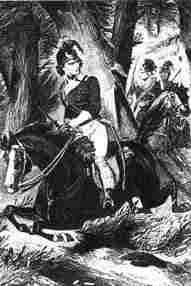What is Guerrilla Warfare?
Special Ops Units are elite forces that engage in unconventional
(i.e., guerrilla) warfare. Today the US military relies heavily on elite
units like the Rangers, Green Berets, Delta Force, and SEALs to accomplish
missions requiring smaller, more highly skilled and specialized units.
Guerrilla is Spanish for "little war" and it originated with
the actions of small bands of Spanish soldiers who fought against
Napoleon's French army in the Peninsular War (1807-1814).
Sun Tzu argued that the way to defeat a more powerful enemy is to employ
your strength to exploit his weaknesses. Chinese Communist leader Mao
Zedong described his tactics: "The enemy advances, we retreat; the
enemy camps, we harass; the enemy tires, we attack; the enemy retreats,
we pursue." |

The Swamp Fox -- General Francis Marion |
The Beginnings of Army Special Operations in America
During the 17th Century, European wars were fought by assembling
large formations and meeting the enemy on open ground--tactics that were
unsuitable for America's limited manpower and vast wilderness areas.
The history of US Special Operations Units begins with the French and
Indian Wars (1754-1763), where France and it's colonial allies fought
against England and it's colonial allies. France and England had been
battling each other off and on in Europe for centuries. In the new
world, France laid claim to most of the US west of the Blue Ridge
mountains"land that was later sold to the US as the Louisiana
Purchase. France claimed the land, but couldn't control the vast
territories and when English colonists began settling there it led to
war.
Early in the war, the objective was to harass the enemy till he decided
to leave an area. Small independent units were much more effective in
pursuit of this goal.
Rogers' Rangers
The first and most famous of these units was known as "Rogers'
Rangers" after their commander Major Robert Rogers. The Rangers
wore distinctive green outfits and practiced tactics called
"Rogers' Rules of Ranging," that the British considered
unsporting, if not downright cowardly because they included sound advice
such as, "If you are obliged to receive the enemy's fire, fall, or
squat down, till it is over; then rise and discharge at them."
Major Rogers hired men solely on merit and shocked regular commanders
with his use of Indians and freed slaves
Rogers Rangers roamed the countryside between the New England states and
Detroit attacking French army supply convoys and small units. They also
sacked and burned French colonial homes and farms. These tactics were
effective in forcing the French and their allies to abandon the
countryside and concentrate their forces in Quebec, Montreal and
Detroit. The British and their colonial allies then concentrated their
forces to lay siege to each city in turn until it fell and they could
move on to the next. By the time Detroit fell the British had control
over all of North America
The Swamp Fox
The greatest guerrilla fighter in the American Revolution was General
Francis Marion. He formed Marion's Brigade in 1780, with one hundred
fifty tattered and penniless patriots. None received pay, food, or even
ammunition from the Continental Army, but they terrorized the British
Army in South Carolina and Georgia with a series of hit and run raids in
the face of overwhelming odds. Marion and his men would strike swiftly
and then vanish into the swamps. His tactics were so effective that he
was nicknamed "The Swamp Fox" by one very frustrated British
general.
Later in the war, Marion and his men combined with the larger regular
army forces operating in the area to attack and defeat the British in
South Carolina's big cities. In 1781, he rescued an American unit that
was surrounded by British forces at Parker's Ferry, South Carolina,
and received the thanks of Congress for his efforts. His victories
eventually drove British forces out of South Carolina entirely.
For more guerrilla warfare, see Guerrilla
Warfare Part 2: The Civil War |




